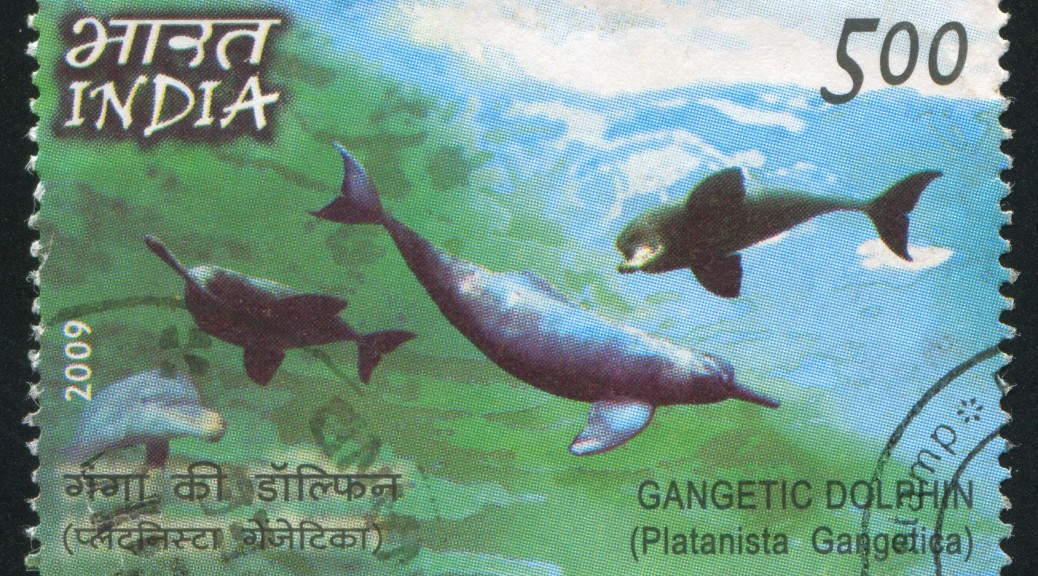Author: Silvia Cohn | December 2014
Abstract
The Ganga River is one of the largest rivers in the world. It has important cultural significance since it is considered sacred in the Hindu tradition. It runs through India and Bangladesh with tributaries that spread outward into other parts of Asia. Since ancient times, many people (now living in densely populated areas) have relied on this river for their daily needs. As a result of the industrial revolution, the Ganga River has worked its way up to being one of the world’s most polluted rivers. The Ganga Action Plan (GAP) was launched in 1986 as an initiative to protect the river. This study will explore what lead to this environmental disaster and why GAP was unsuccessful.
Keywords: River, Ganga, Ganges, India, Bangladesh, trans boundary, water use, pollution, effluent, regulation, the Ganga Action Plan
Figure 1. Map of the Ganga River Basin
loading map - please wait...
Introduction
The Ganga River Basin has been called the “lifeline of millions” since it is a trans boundary river with tributaries stretching through the Himalayas of Nepal and India, the great plains of India, West Bengal, and Bangladesh (Sanghi, 2014).
The river is considered holy in India and was formally named the national river in 2008. It is known as the Ganga in Indian languages though it is also called the Ganges River.
“The Hindus sprinkle its [Ganga’s] water for purification and worship and take bath in it in the belief, supported by scriptures that it cleanses their sins. They arduously trek to its source in a snow-bound Himalayan glacier, Gangotri and downstream at Haridwar, float lighted oil lamps on its water after dusk in memory of their deceased elders. In earlier days, the Hindus used to leave their dying kith and kin on its shores, or lodge them in Varanasi on its bank, so that their souls could ascend to heaven when they died” (Parua, 2010).
Ganga Aarti is a ritual performed every evening in devotion to the Goddess Ganga using fire as the offering. A diya (lamp) is lit with a candle and is floated down the river along with some flowers. This powerful ritual is perfomed primarily in the three holy cities Haridwar, Rishikesh, and Varanasi in India.
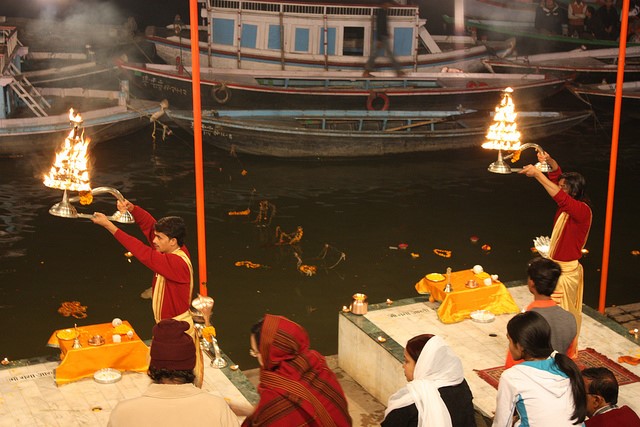
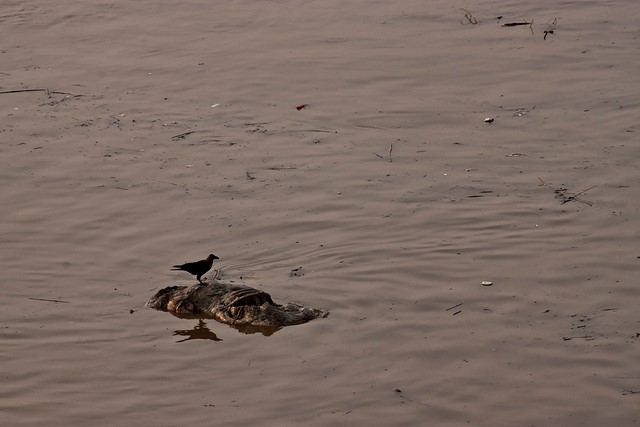
In contrast to the beauty of Ganga Aarti, funeration practices result in the foul sight and odor of corpses and decomposing human parts found floating in the water. Though the traditional practices such as dumping corpses and ashes of the deceased are minor compared to the industrial practices, in terms of pollution, they still need to be considered as part of the culture. A journalist from the Smithsonian visited the Ganga to talk to environmentalists, scientists and local people. Joshua Hammer tours the foul sites with a 48-year-old environmental activist by the name of Rakesh Jaiswal as his guide. Here Hammer reports what he sees in Kanpur, India:
“. . .just downstream from a Hindu cremation ground, we’re hit by a putrid smell and a ghastly sight: lying on the sand are a human rib cage, a femur, and, nearby, a yellow-shrouded corpse. “It’s been rotting there for a month,” a fisherman tells us. The clothed body of a small child floats a few yards off the island. Although the state government banned the dumping of bodies a decade ago, many of Kanpur’s destitute still discard their loved ones clandestinely at night. Pariah dogs prowl around the bones and bodies, snarling when we get too close. “They live on the sandbar, feeding on the remains,” a fisherman tells us.” (Hammer, 2007)
Surely the appearance of the river today doesn’t seem keen for bathing. It seems anything but pure and holy. Yet people still use the river and even children remember how the river has changed in their lifetime but still splash around as if it hasn’t, whether in religious practice or not. On the same trip Hammer reports:
“As we near the tanneries, a dozen boys frolic in the water, splashing in the river’s foulest stretch. Jaiswal calls them over.
‘Why do you swim in the river?’ I ask one of the boys. ‘Aren’t you worried?’
He shrugs. ‘We know it’s poisonous,’ he says, ‘but after we swim we go wash off at home.’
‘Do you ever get ill?’
‘We all get rashes,’ he replies, ‘but what can we do?'”(Hammer, 2007).
In other interviews it is revealed that even in the parts that are the most polluted, people still revere the river as an earthly incarnation of a deity, “Mother Ganga,” who’s water purifies all simply through touch, consumption, or expression only in name. Somehow their faith allows them to ignore the realities of the illness it causes, as minor as a skin rash or as major as increased infant mortality rates, which only makes it worse (Hammer, 2007).
To them the lifeline never stops and they clearly accept it for what it is in order to make room for growth and also because they value their beliefs more than the physical realities. The reality is that India’s population and industry have been rapidly growing. The population of India is now over 1.2 billion, second only to China (see figure 3).
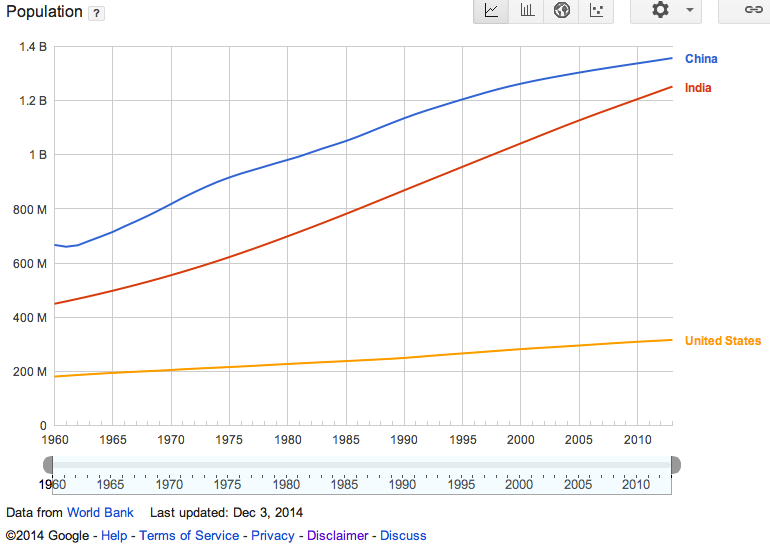
Water Use and Impact of Pollution
Health problems occur because of direct contact with the water from people bathing in, drinking, or doing laundry in the river. In addition the crops that are irrigated with the water as well as dairy products have been found to contain high levels of chromium and arsenic, which originates mainly from the tanneries. Though other liquid effluents also find there way in to the river, tannery waste is considered the most polluting. The following table shows the typical characteristics of the effluents recorded in a case study by Pandey (1988) compared to what the allowable limit would be. The case study was conducted in Kanpur, India where there is a high concentration of tanneries and where much of the pollution originates. “Kanpur has 151 tanneries located in a cluster at Jajmau along the southern bank of the Ganga with an estimated waste water discharge of 5.8 to 8.8 million litres per day” (Tripathi, et al. 1988).
Figure 4. Typical composite effluent characteristics (Based on Tripathi, et al. 1998)
| Parameters | Values, water with tannin (in Ganga, at Kanpur) | Values, standard water |
|---|---|---|
| Color | Greenish yellow | Dark yellow |
| Odor | Pungent tan | Mild |
| Turbidity | Turbid | Clear |
| Temperature | Ambient | Ambient |
| pH | 9.2 | 7.5 |
| Suspended solid concentration | 40100 mg/l | 400 mg/l |
| Chloride | 8000 mg/l | 1500 mg/l |
| Chromium | 150 mg/l | 130 mg/l |
| COD | 6854 mg/l | 1500 mg/l |
| BOD | 2596 mg/l | 100 mg/l |
| Oil and grease | 350 mg/l | 50 mg/l |
| Tannin | 100 mg/l | 50 mg/l |
| BOD=Biological oxygen demand, a measure of the quantity of dissolved oxygen necessary for the decomposition of organic matter |
Raw sewage is also dumped in the water, which can spread disease that can even make its way into the crops that people then eat. The problem is simply that the current treatment plants can’t handle the amount of sewage that they receive. Hammer noted this issue first hand when he visited Kanpur with Jaiswal.
“A few yards upstream, we follow a foul odor to a violent flow of untreated domestic sewage gushing into the river from an old brick pipe. The bubbling torrent is full of fecal microorganisms responsible for typhoid, cholera and amoebic dysentery. Ten million to 12 million gallons of raw sewage have been pouring out of this drainpipe each day, Jaiswal tells me, since the main sewer line leading to the treatment plant in Kanpur became clogged—five years ago” (Hammer, 2007).
A similar issue occurs with the treatment of the industrial effluent of large quantity and inadequate facilities as well as disregard of regulation. This is a huge problem since “It accounts for about 31.6 percent of India’s annual utilizable water resources, providing water for agriculture, aquaculture, hydro- power generation, industry, and water supply for household consumption. The Ganga is a major input to agricultural production, as the soil in the river basin is very fertile, and the river provides a perennial source of irrigation to a large area, enabling cultivation of several crops” (Birol, et al. 2010).
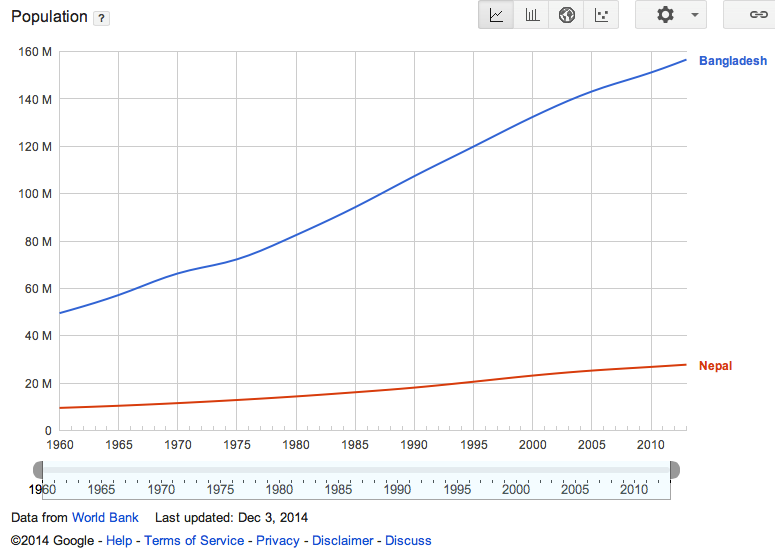
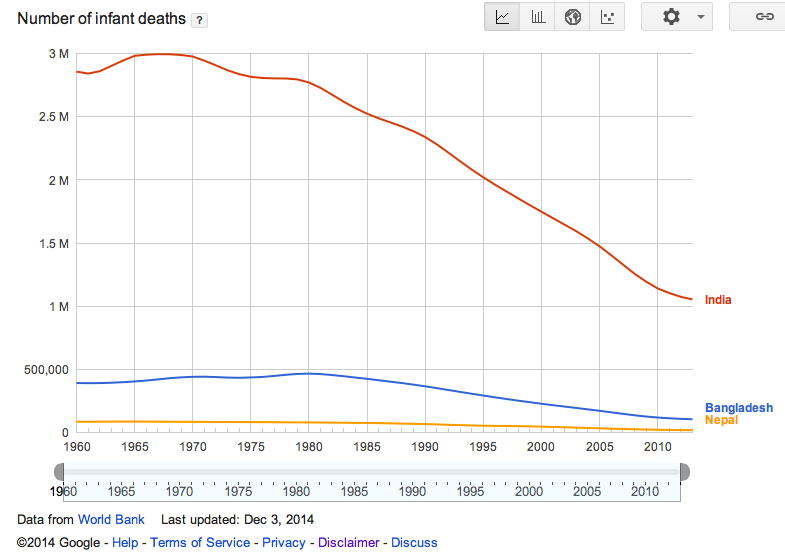
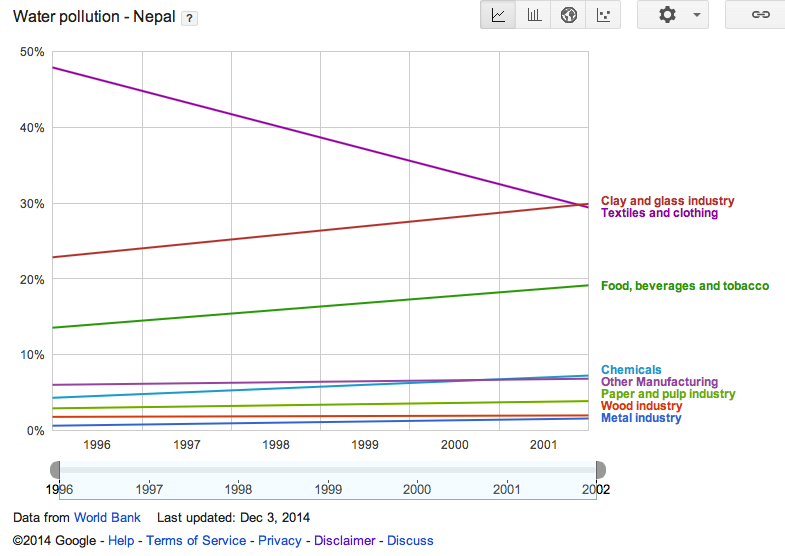
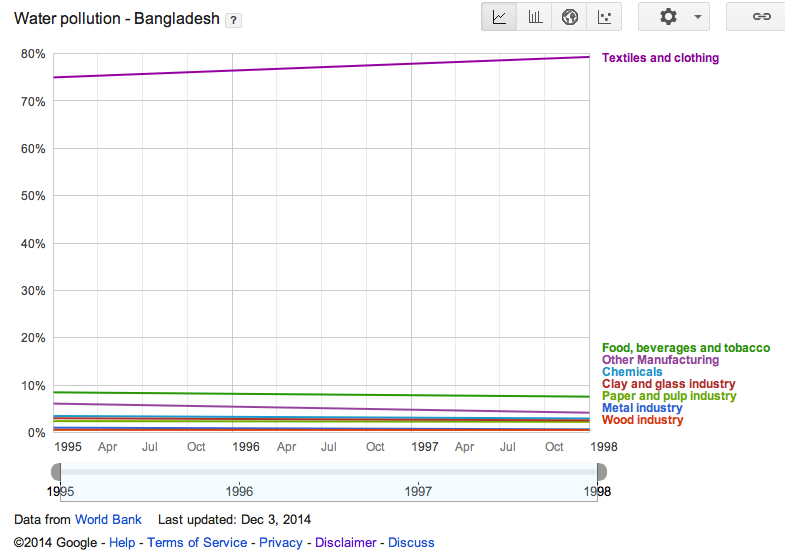
All of the Figure 5 charts were creating using all available public data from the World Bank. This data provides indication of world development in terms of population, health, and industry, and the environment. Industry is also the primary contributor to water pollution in Bangladesh and Nepal. Textiles and clothing are the major contributors in both countries though clay and glass is also notable in Nepal (see figure 5c and 5d). Like India, these two countries have also experience rapid population growth though their populations are still in the millions (See figure 5a). Infant mortality is a determinant of demographic transition, which is indicative of the development of a country as well as national health. The infant mortality rate for India was really high (see figure 5b) though is on the decline, likely because more people have access to cleaner water now (see figure 5e).
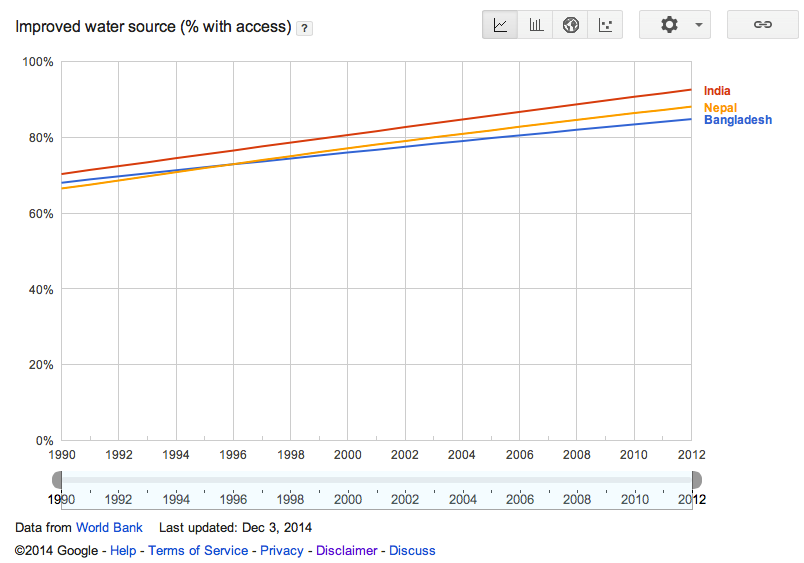
However, the available water sources are still being depleted. Figure 5F. shows that the amount of renewable freshwater (in cubic meters) per capita has decreased significantly in all three countries.
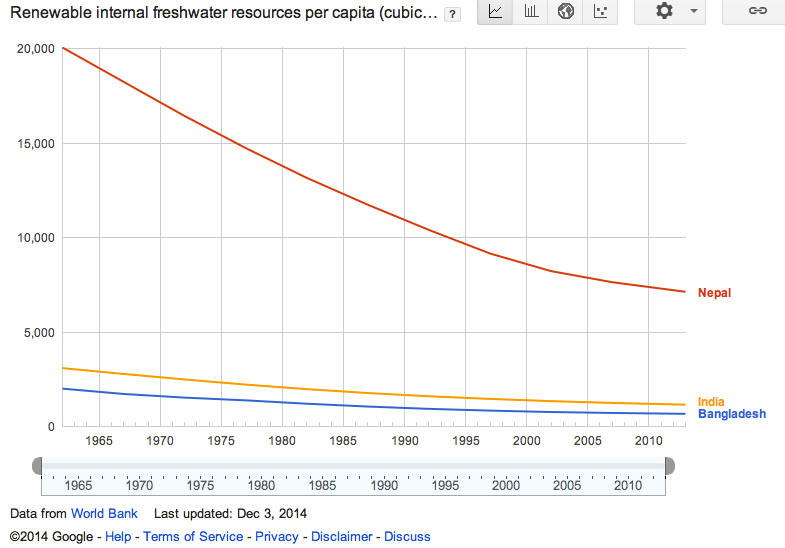
In addition to making the water nearly unusable to humans, pollution is also detrimental the ecosystems within the river itself. Endangered species such as dolphins provide an indication of the health of the river. In addition to pollution other anthropogenic activities that result in habitat destruction affect biodiversity in the Ganga River. The Ganga river dolphin (Platanista gangetica gangetica), which is critically endangered, serves as an indicator species given its major role as the only mammalian predator of the river. The dolphin is endemic to the Ganga and was recently named the national aquatic animal of India in January 2010. It is often called “Susu” or “Soons” locally because of the sound it makes when it breathes in air through its blowhole. The population of the dolphin has been dropping rapidly and has been reduced to zero in some stretches of the river while thinning in others. According to the WWF the population was estimated to be 4,000-5,000 in 1982 and is now approximately 1,200-1,800 individuals. In addition, “The distribution in the Ganges has diminished by approximately 100 km (62 miles) since the 19th century, with hundreds of kilometres of tributary habitat lost to irrigation barrages” (WWF, 2006). Reduced water flow has been determined to be the major threat. Some stretches of the river are completely barren of life because of pollution and habitat loss. “Beside the Ganga River dolphin a total of 40 species of zooplanktons, four crustaceans, 15 molluscs, 51 insects, 83 fishes, 12 freshwater turtles, 2 crocodiles and 48 aquatic birds species have been identified [as endangered] in the upper Ganges River”(Sanghi, et al. 2004).
Photosynthetic activity is also a good indication of water quality in terms of river ecology since it relates to biochemical oxygen demand (BOD) and dissolved oxygen (DO) levels. Pressures on the river resulting from organic loading were a major focus of stage 1 of the GAP, which focused on the reduction of organic effluents in the river. Efforts were made to intercept, divert and treat wastewater reaching the river, thus maintaining the biochemical oxygen demand (BOD) and dissolved oxygen (DO) levels of river within the acceptable limits.
A research case study on the most polluted stretch of the river, known as Kannauj-Kanpur, was conducted Tare and colleagues in order to assess the photosynthetic activity and oxygen production rates in the river and correlate these values with various water quality parameters.
“Based on the results of the study, it was concluded that despite implementation of phase I of GAP, and consequent diversion and reduction of organic loading to the river, both BOD and DO levels in the river has increased in the entire Kannauj –Kanpur stretch, except at Jajmau, where anaerobically treated effluent is discharged to the river. The nitrogen levels have also increased in the entire Kannauj–Kanpur stretch. Dissolved oxygen (DO) and alkalinity in the river water vary diurnally at all sites.” (Tare, et al. 2003)
The research was conducted through statistical analysis of historical data. Figures 6a. and 6b. show the analysis of the data that they collected and compares the numbers from before and after the implementation of GAP. Figure 6b. is specific to Kanpur city and shows that organic loading did not stop though the rate of increase has somewhat slowed. Unfortunately, loading in the city was still greater in 2000 than it was in 1985 (ie. Before GAP phase I).
Figure 6a. Ganga water quality in the Kannauj-Kanpur stretch pre and post Ganga Action Plan (GAP), Phase 1 (Based on Tare et al, 2003)
| Site | 1983-89 (before GAP, Phase 1) | 1997-99 (after GAP, Phase 1) | Trend | ||||||||
|---|---|---|---|---|---|---|---|---|---|---|---|
| Avg. | Max. | Min. | Std. Dev. | n | Avg. | Max. | Min. | Std. Dev. | n | ||
| A. Biochemical oxygen demand (BOD) in mg/L | |||||||||||
| Kannauj | 3.90 | 7.18 | 1.63 | 0.48 | 39 | 3.76 | 6.80 | 2.30 | 0.61 | 36 | Unchanged |
| Shuklaganj | 3.15 | 6.26 | 0.67 | 1.15 | 80 | 4.97 | 7.23 | 3.20 | 0.72 | 36 | Increasing |
| Jajmau | 8.25 | 16.1 | 2.42 | 1.8 | 84 | 6.35 | 12.10 | 3.46 | 1.33 | 36 | Decreasing |
| B. Dissolved oxygen (DO), in mg/L | |||||||||||
| Kannauj | 7.50 | 9.41 | 4.80 | 0.13 | 41 | 7.73 | 9.63 | 6.20 | 0.24 | 36 | Increasing |
| Shuklaganj | 7.88 | 9.88 | 5.37 | 0.27 | 84 | 7.12 | 9.80 | 5.66 | 0.17 | 36 | Decreasing |
| Jajmau | 6.77 | 9.10 | 4.15 | 0.83 | 84 | 6.40 | 10.1 | 3.10 | 0.32 | 36 | Decreasing |
| C. Total Kjeldahl nitrogen (TKN), in mg/L (as N) | |||||||||||
| Kannauj | 4.00 | 9.43 | 0.68 | 1.47 | 37 | 3.28 | 4.42 | 1.93 | 0.47 | 36 | Decreasing |
| Shuklaganj | 1.97 | 4.68 | 0.43 | 1.77 | 81 | 4.43 | 6.10 | 2.85 | 0.58 | 36 | Increasing |
| Jajmau | 3.54 | 9.16 | 0.57 | 2.58 | 84 | 4.49 | 6.56 | 3.07 | 1.00 | 36 | Increasing |
Figure 6b. BOD loading in Kanpur (Based on Tare et al, 2003)
| No Intervention | GAP, Phase 1 | |
|---|---|---|
| 1985 | ~17,000 | |
| 1993 | ~20,000 | ~15,000 |
| 2000 | ~35,000 | ~22,000 |
This study provides a fair assessment of the oxygenation potential which represents the capacity of the river to deal with waste. This assessment is useful in planning for the implementation of future regulations.
Pollution concentration in the Ganga is exacerbated by water being removed in large amounts for agricultural irrigation. In 1980, the Indian government decided not to tolerate the situation any longer. The fact that their people like to bathe in the “holy” river made the issue impossible to ignore. A survey to determine the extent of pollution in the river Ganga was conducted in 1980 by the Central Board for Prevention and Control of Water Pollution, New Delhi, (now known as Central Pollution Control Board) at the request of the Department of Environment of the Indian Government. In 1985, the Ganga Action Plan (GAP) was prepared based on the results of this survey (CPCB 1982–83).
Initially, the main goal of GAP was to restore the entire river to “Class B” or “Bathing Class.”
Figure 7. “Bathing Class” water quality (From Tare et al. 2003)
| Class B | Outdoor bathing (organized) | pH: 6.5-8.5 DO: 5 mg/L or more BOD: 3 mg/L or less Total coliform: 10,000 MPN/100 mL or less Fecal cliofrm: 2,500 MPN/100 mL or less |
“These included 88 sewage interception and diversion, 35 sewage treatment, 43 low-cost toilets, 28 electric crematoria, 35 riverfront development and another 32 schemes of miscellaneous category” (National River Conservation Directorate sited in Tare et al, 2003).
Though an improvement was reported due to GAP phase I, the river was still not restored to bathing quality. “According to a 2001-2002 government survey, the treatment plants could handle only about a third of the 600 million gallons of domestic sewage that poured into them every day. (The volume has increased significantly since then)” (Hammer, 2007).
In response to the lack of success in phase I, GAP phase II modified the approach. Instead of focusing on the whole river “Ten stretches of the river were identified for receiving priority attention in cleaning up operations to achieve Bathing Class standard. All these stretches were near holy places, i.e., places where large numbers of pilgrims bathed in the river. GAP phase II is currently under implementation at various places along the river Ganga.” (Tare, et al. 2003) In 2000, the plan required 100 large- and medium-sized Kanpur tanneries to set up chrome-recovery facilities of their own and 100 smaller ones to build a common chrome-recovery unit. Unfortunately enforcement was too lax and some tanneries are still putting chrome into the river without any treatment or dumping it into the domestic sewage system (Hammer, 2007).
The failures of GAP have been accredited to lack of financial sustainability and lack of public support. After spending millions and not seeing improvement the plan was withdrawn in 2000. There were also inherent issues with the plan itself that are accredited “to lack of will and technical expertise, lack of sound (environmental) planning, [our] age old traditions and beliefs, and lack of support from religious corners.” (Sanghi, 2014) The problem is not lack of money. In fact,
“Many environmentalists say that the Ganges has become an embarrassing symbol of government indifference and neglect in a country that regards itself as an economic superpower. ‘We can send a shuttle into space, we can build the [new] Delhi Metro [subway] in record time. We can detonate nuclear weapons. So why can’t we clean up our rivers?’ Jaiswal [an environmental activist] laments. ‘We have money. We have competence. The only problem is that the issue is not a priority for the Indian government’” (Hammer, 2007).
River Cleanup
Rivers around the world suffer from the negative impacts brought about by increased industrial activity from rapid economic growth of a country. As a result, several rivers around the world require cleaning-up operations. These rivers, like the Ganga, have been categorized as very polluted with universal impacts such as contamination of rivers, sedimentation, coastal erosion, decrease of aquatic life, and also flooding.
“The management of rivers usually involves several authorities and agencies both Federal and Local enforcing Acts and Regulations. Table 1 gives an example of a typical list showing involvement from four different Federal Ministries and one from the State government.” (Ismail et al, 2012)
Figure 8. Management of rivers (Based on Ismail, et al. 2012)
| Agency | Function related to river banks |
|---|---|
| Department of Irrigation and Drainage and Ministry of Agriculture | Irrigation for agriculture, flood mitigation and defense, river rehabilitation and maintenance |
| State Water Supply Department, State governments | Water abstraction, water treatment and water supply |
| Local authorities, Ministry of Housing and Local government | Physical land development within the river basins, sewage treatment plants |
| Department of Environment (DOE), Ministry of Science, Technology and Environment | River quality monitoring, effluent compliance monitoring, administering and enforcing EQA 1974 |
| Ministry of Energy, Water and Communication | Planning the development and legislation of licensing policies, strategies and regulations as well as the formation of legal subsidiaries |
A study in the Clean Journal assessed the effectiveness of several cleanup operations. In some cases river authorities had to be streamlined for a clearer line of reporting. Another important factor was the utilization of the appropriate efficient technological equipment to handle the job adequately. Infrastructure can also be built to mitigate floods and runoff. Ideally, research should also be regularly conducted to monitor effluent and the health of the river. This report also concluded with a strong emphasis on public awareness and cooperation, which are necessary for the system to be well operated and well maintained.
In addition, the Clean Journal report gave the example of Local Agenda 21 (LA21), which was adopted in Malaysia to help unify efforts by partnering local authorities, NGOs, and local communities. Through this program, local communities work with local authorities to identify local issues so that they can address them. LA21 adopts a “top-down” and “bottom-up” approach whereby local communities are also involved with analyzing the issues and planning for action from the beginning.
Other Forms of Regulation
In the same paper that talks about modifications for GAP, Tare and colleagues argue that:
“Public support and cooperation is essential for proper implementation of the initial phase GAP and other similar plans. For the successful implementation and sustainability of projects, it is essential that public expectations from its implementation be adequately fulfilled. This can only be achieved by ensuring public and NGO participation in planning, implementation and maintenance of schemes” (Tare, et al. 2003)
This seems to hold true since the issue is so widespread and affects so many people so it is difficult for the government to monitor everything so smaller entities need to be responsible for being aware of pollution levels. Irrespective, the formal environmental regulation system, based on command and control, has not been effective in controlling water pollution in India. When formal regulation is deficient, informal regulation through local community participation can force the polluter to comply. Informal regulation can take the form of demand for compensation by community groups, social ostracism of anyone associated with the business, the threat of violence, or efforts to monitor and make public the levels of the business’s emissions. “Two ‘formal’ channels of informal regulation are (1) to report violation of legal standards to the regulatory institutions (where such standards and institutions exist), and (2) to put pressure on regulators (politicians and administrators) to tighten their monitoring and enforcement” (Goldar et al, 2004).
An econometric analysis of determinants of water quality in Indian rivers was carried out using water quality (water class) data for 106 monitoring points on 10 important rivers for five years, 1995–1999 (see figure 6). A paper explaining the study was published in the Journal of Environmental Management. The study found:
“A significant positive relationship is found between poll percentage and water quality, and also between the rate of increase in literacy level in a district and the water quality in rivers flowing through the district. These results point to a significant favorable effect of informal regulation of pollution on water quality in rivers in India” (Goldar et al, 2004).
Figure 9. Water quality of the Ganga River (Based on Goldar, et al. 2004)
| Explanatory variables | Model I | Model II | Model II | Model IV | Model V | Model VI |
|---|---|---|---|---|---|---|
| Rainfall | 0.00021 (1.7) | 0.00021 (1.7) | 0.00011 (0.9) | 0.00008 (0.6) | 0.00007 (0.5) | 0.00014 (1.1) |
| Increase in literacy | 0.02831 (2.6)** | 0.02763 (2.6)** | 0.02543 (2.2)* | 0.02319 (2.0)* | 0.01471 (1.2) | 0.03021 (2.5)* |
| Poll percentage | 0.01848 (3.6)** | 0.01905 (3.7)** | 0.01987 (3.9)** | 0.02255 (4.5)** | ||
| Urbanization (URB) | -0.01671 (-1.7) | |||||
| URB-squared | 0.00019 (1.8) | |||||
| Industrialization (IND) | -0.0685 (-3.5)** | -0.0507 (-2.4)* | -0.0694 (-2.8)** | -0.0554 (-2.2)* | ||
| Irrigation intensity (IRRI) | -0.0064 (-2.3)* | -0.0034 (-1.0) | ||||
| D_IRRI | -0.3345 (-2.8)** | |||||
| D_FERTL | -0.3857 (-2.8)** | |||||
| IRRI*D_FERTL | -0.0046 (-1.7) | |||||
| IND*D_9899 | 0.06422 (2.8)** | 0.06596 (2.9)** | ||||
| LR chi-square (df) | 9.3 (2) | 21.4 (3) | 46.8 (5) | 57.6 (7) | 70.6 (7) | 31.8 (5) |
| No. of observations | 472 | 472 | 467 | 467 | 467 | 472 |
The study was based on the idea that level of education, degree of political organization and environmental awareness are considered to be important factors that determine the strength of informal regulation. Informal regulation is also influenced by information, legal or political recourse, media coverage, the presence of non-government organizations (NGOs), and the efficiency of existing formal regulation (Goldar et al, 2004).
WASH Institute in India is an example of an NGO organization that recognizes the need for education on issues of sanitation. It stands for WAter, Sanitation, and Hygiene Institute with the motto of “Bridging the knowledge gap for community based sustainable solutions”
WASHi has created several training programs across South Asia. Their mission is to facilitate development of skilled professionals in water and sanitation sector with a community perspective to address the growing need of trained human resources in the sector. Their mission also states that they intend to connect the community with service providers “…through education and training to assist the stakeholders in planning, implementation, operation and management of water, sanitation, hygiene and environmental programmes on a sustainable basis.” As a result, their actions have implications in shaping policy. (WASH Institute, 2013)
Conclusion
In a modern election, the leading candidate promised to cleanup the river. Narendra Modi, in his campaign for prime minister made the cleanup of the sacred river a metaphor for his campaign. In a rally leading up to the voting results he said “I feel Mother Ganga has called me to Varanasi. . . I feel like a child who has returned to his mother’s lap,” (Modi quoted in Sinha, 2014). He is responding to a need to a need to reorganize the government and “He says he wants to restore the river’s purity just as he will revive a nation sullied by corruption and stalled by mismanagement and bureaucratic sloth.” (Sinha, 2014). Thankfully he was elected in May of 2014. Though it is still early in his career, he brings hope for a new clean up plan for both the river and the government. Moreover, the success of his campaign may hopefully indicate an alignment of the people’s demands with his values as a leader.
As we have seen, smaller scale (informal) regulation has been effective. It seems that there will also be some larger scale regulation to come as well. The issue of top down and bottom up efficiency in terms of pollution issues is shown by this case study. Efforts need to be made from all directions.
References
Ekin, B., & Sukanya, D. (2010). Estimating the value of improved wastewater treatment: The case of river ganga, India. Journal of Environmental Management, 91(11), 2163–2171.
Goel, P. K. (2006). Water pollution: Causes, effects and control (revised ed.) New Age International.
Goldar, B., & Banerjee, N. (2004). Impact of informal regulation of pollution on water quality in rivers in india. Journal of Environmental Management, 73(2), 117–130.
Hammer, J. (2007, November 2007). A prayer for the ganges. Smithsonian Magazine
Ismail, Z., & Salim, K. (2013). Determination of critical factors in implementing river clean-up projects: A Malaysian case study Clean Journal, 1(41), 16-23.
Parua, P. K. (2010). The ganga water use in the Indian subcontinent. B.V.: Springer Science+Business Media.
Sanghi, R. (Ed.). (2004). Our national river ganga: Lifeline of millions. Switzerland: Springer International Publishing.Sinha, S. (2014, May 14, 2014). Ganges river: Revered, soiled and symbol of an Indian election campaign. The New York Times
Tare, V., Gupta, S. K., & Bose, P. (2003). Suggestions for a modified approach towards implementation and assessment of ganga action plan and other similar river action plans in India Water Qual. Res. J. Canada, 38(4), 607-626.
Tare, V., Veer, A., Yadav, S., & Bose, P. (2003). Analysis of photosynthetic activity in the most polluted stretch of river ganga Water Research, (37), 66-77.
Tripathi, N. K., Venkobachar, C., Singh, R. K., & Singh, S. P. (1998). Monitoring the pollution of river ganga by tanneries using the multiband ground truth radiometer. ISPRS Journal of Photogrammetry and Remote Sensing, 53(4), 204–216.
Wash Institute. Annual Report: 2012-2013. No 7/45E Vol. Tamil Nadu, India:, 2013. Print.
WWF. (2006). Species/Freshwater fact sheet: River dolphins Retrieved from http://wwf.panda.org/what_we_do/endangered_species/cetaceans/about/river_ dolphins/ganges_river_dolphin/
Featured Image Copyright: <a href=’http://www.123rf.com/profile_rook76′> / 123RF Stock Photo</a>

